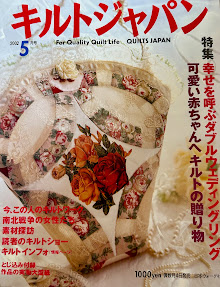I wandered into the Shibori Dragon quilt store in University Place, WA, today to get some hand-dyed wool and was blown away by the boro jacket collection hanging on the walls. I got permission from Becky, who has been collecting the treasures for about 25 years, to take photos and put them on the blog.
Boro ("ragged") jackets are Japanese clothing mostly from the 19th and early 20th centuries that have been heavily patched and mended. The fabric is indigo dyed and the stitching with thick threads is called sashiko.
These first few pieces that I'm showing you are from the 1930s-1940s and are from Northern Japan. I love the simple, loose, geometric shapes of the patches and stitching.
I found this additional information about boro at www.srithreads.com, the web site of a textile gallery in New York specializing in antique Japanese folk textiles:
"The diversity of patches on any given piece is a veritable encyclopedia of hand loomed cotton indigo from old Japan. In most cases, the beautiful arrangement of patches and mending stitches is borne of necessity and happenstance, and was not planned by the maker.
"Imagine that boro textiles were stitched in the shadows of farmhouses, often at night by the light of one dim andon, on the laps of farm women. This unselfconscious creative process has yielded hand-made articles of soulful beauty, each of which calls upon to be recognized and admired as more than the utilitarian cloth they were intended to be."
This next garment (above and below) is a fisherman's coat from 1868-1912. The sign beside it says the densely spaced stitches made the cloth thicker and warmer and provided a way to reuse old fabric, just as Americans do in patchwork quilts. The quilted coats were originally a necessity to keep fishermen warm and dry at sea in the days of sail and oar. Over time they evolved into ceremonial robes.
This garment half hidden by bolts of lavender fabric is a Japanese farmer's boro noragi coat from the late 1800s to very early 1900s in the Shiga prefecture of Central Japan.
It is sakiori loomed, which is a woven fabric produced from worn out cloth and garments torn thinly and then woven tightly into clothing and other products for daily use. As such, it is very heavy.
The sashiko (spellcheck keeps trying to change this to "sashimi") stitching on boro is often in geometric patterns, like this section of the fisherman's coat:
So, if you're near University Place by Tacoma, do stop in and view these beauties at Shibori Dragon, 7025 27th St. W. www.shiboridragon.com. And buy some fabric while you're at it!
Have a colorful day




















7 comments:
What a wonderful exhibit! Thank you for taking the time to photograph them and gather the information to share with us. It makes me think of some old hand made quilts we had that were made of scraps of clothing, probably by my grandmother and great-grandmother. Art created out of necessity and the materials at hand... a tradition that spans the globe and throughout history.
I LOVE boro and am working on my own version of a jacket now that is a kind of on again off again project that I am hoping to finish this winter.
Merry Christmas
Wow...these are fantastic! I'm taken by the very first pic you posted! I love that one...how exciting to see these in person and look closely at the stitching. Thanks for the closeup photos so we can enjoy seeing all those stitches and not leave the couch!
love the boro look, big stitch, and denim alot. Sashiko is big here in the islands among quilters and stitcher. What a great way to patch old fav garments too comfy to ditch too! And Like Carol, you can keep adding while you wear it or in my case wearing it out!
I'm sharing this post with my art group. One of our members took a tour through Japan and upon her return introduced us to boros. None of us were familiar with this. She and another member have since both tried their hand at making something with this ancient technique. They will so love seeing these photos. Thanks for taking the time to capture them and sharing.
Impressive patterns. Jacket Back Digitizing Good job.
Japanese boro jackets in Shibori Dragon designs are a beautiful fusion of history, craftsmanship, and art, blending traditional techniques with modern aesthetics. Much like these unique jackets, big puff disposable vapes offer an exceptional experience, combining quality and convenience in a sleek, easy-to-use design. Both showcase an appreciation for intricate detail and craftsmanship, whether it's the careful stitching of the boro jacket or the smooth, satisfying puffs of a big puff disposable vape. Both elevate your experience, offering a blend of comfort and style that fits seamlessly into your life.
Post a Comment